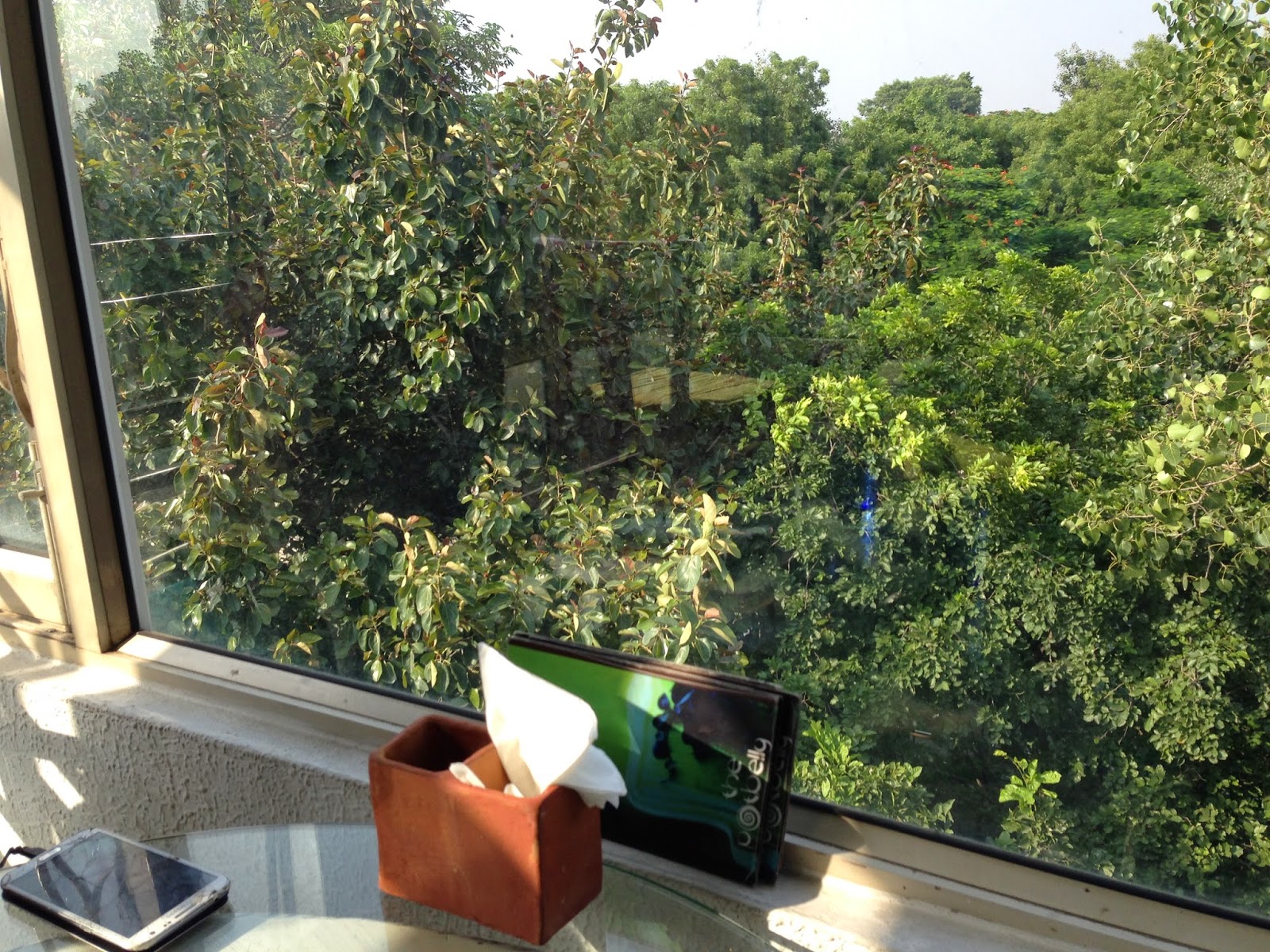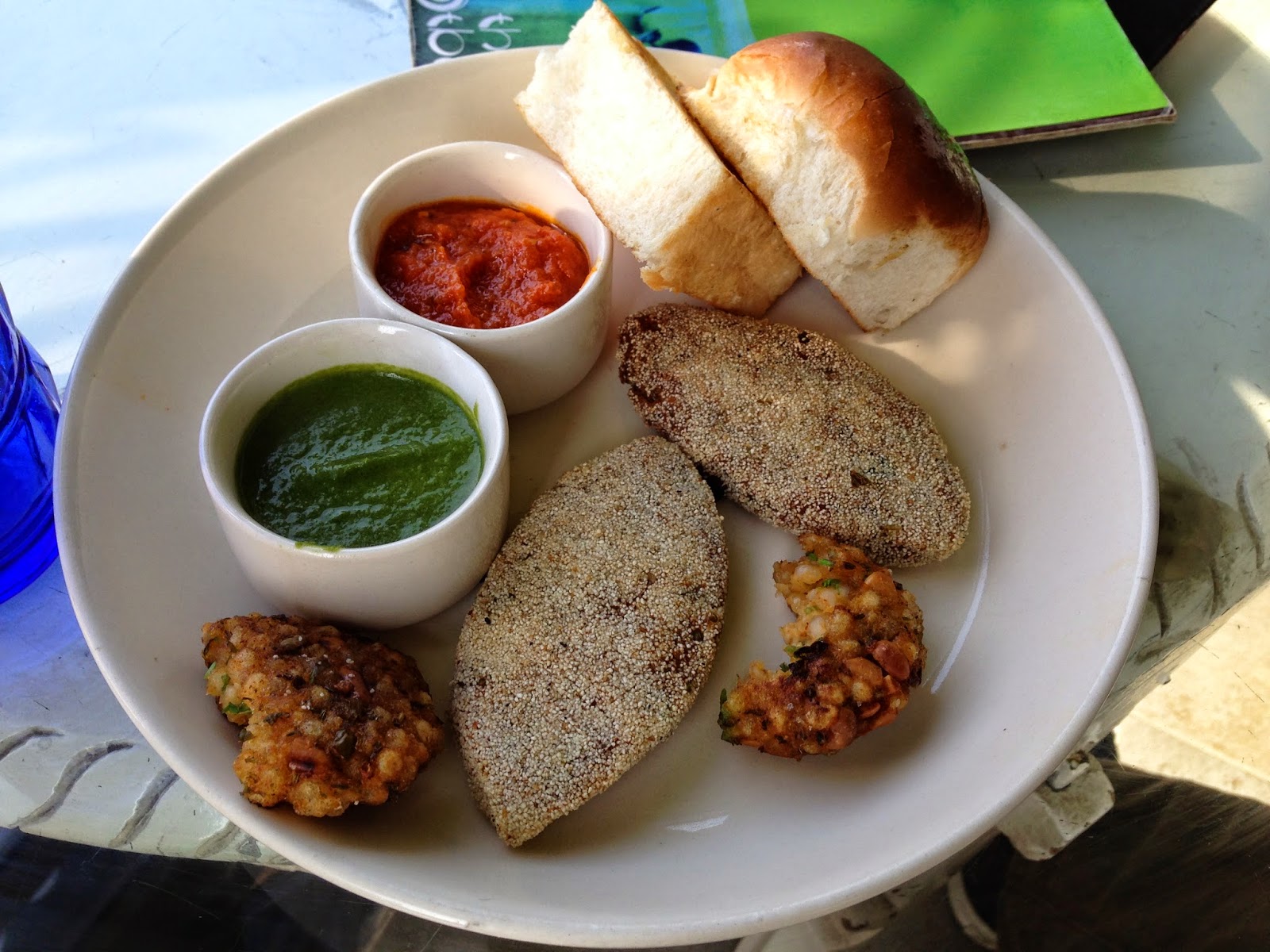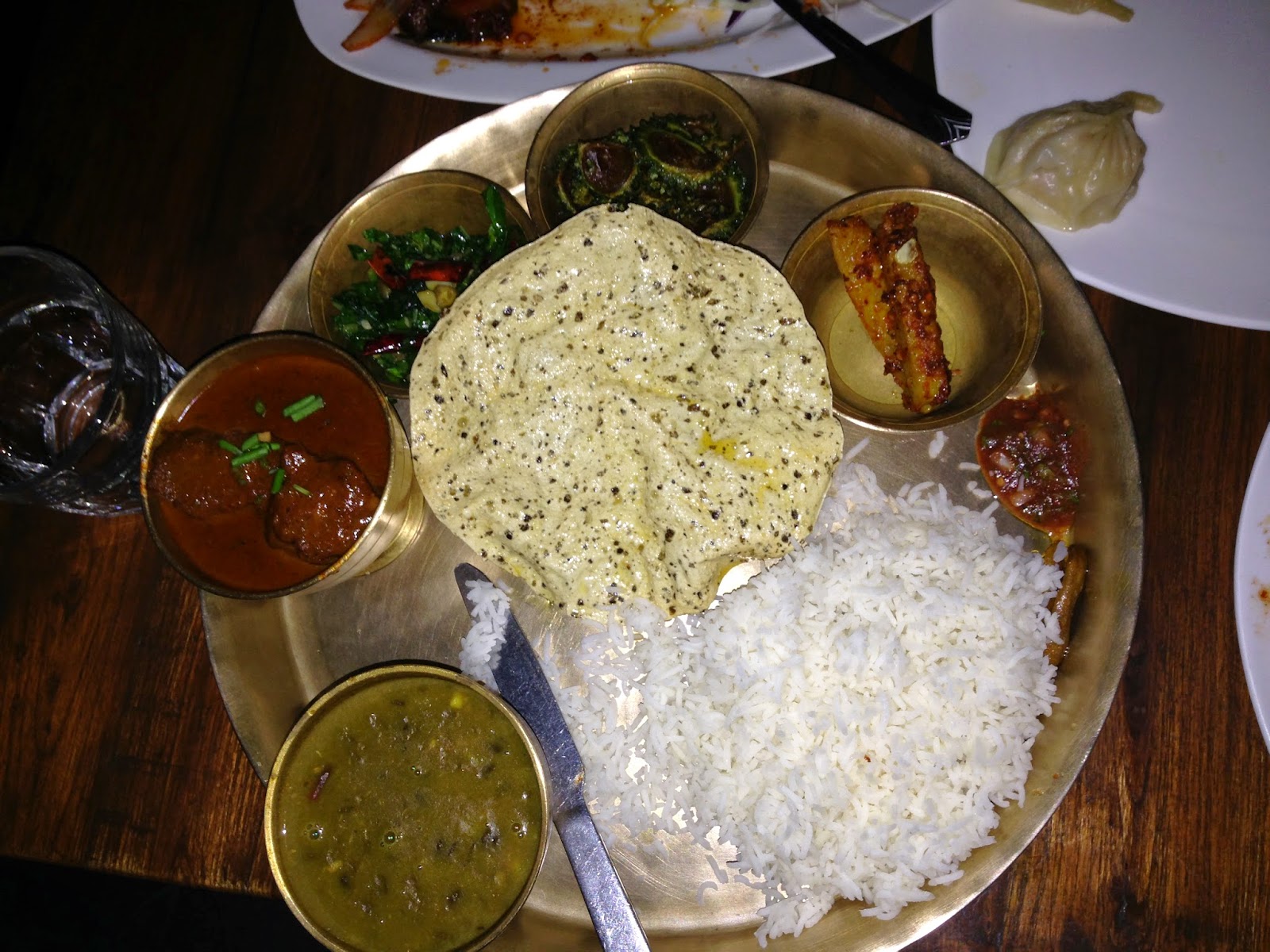Namaste, again. As you may have noticed, I'm a bit behind on the blog. But really, can you blame me? Once the monsoon season ended, it became tougher to sit behind my computer in the morning. Instead, I've been running. Not very far, mind you--the heat makes that difficult for me. It's still 99 on a daily basis. But the humidity went from 90-100% down to 20-30%. Therefore, we all decided to get sick. And now that I'm recovering, it is blog time again. This post will cover some consecutive weekends in Delhi.
In the middle of Delhi is Connought Place. Completed in 1933, it was the former headquarters of the British government in India. Now, it's the fourth or fifth most expensive office space in the world. I'd say it's equivalent to our Nicollet Mall, but the comparison does no justice to C.P., as it's commonly called. Our work team went to C.P. to catch the movie Mary Kom and to have a team lunch. Below is the gigantic Indian flag in the center of the massive and circular green area in the middle of C.P. That flag is 90 feet by 60 feet, or, coincidentally, the length from home plate to first base by the length of the pitcher's mound to the plate. It's a beautiful sight.
Below is the lobby of the PVR Cinema movie theatre. Notice how nice it is. They even had a separate concession stand for air-popped popcorn with no butter or flavoring, and another stand for gelato.
The movie we saw was called Mary Kom. Mary Kom is an accomplished female boxer from North India. She won the bronze medal at the 2012 Summer Olympics in London. She just won the gold medal at the Asian Games this past week. As tough as she is, I think she'll make it to the Olympics in 2016, too. Mary Kom also started a female-only fight club to teach girls to defend themselves against sexual violence. This is an important movie, especially for younger Indian people. I really enjoyed it. Other notes: Indian films have intermissions. Intermissions rule. This movie was not a Bollywood film, so there was no singing or dancing.
Here we are at Zaffron for dinner. It was super good. And spicy, as always. Special thanks to the people who help me order. Today it was Pallavi, Manu and Udhab.
Here are two appetizers we ordered. The chicken was called Drunken Chicken because I think it was cooked in bourbon. That's a big block of soft cheese cooked in curry spices. I believe this cheese is called paneer.
For an entree I ordered mutton and chicken, although we shared pretty much everything.
On this day I got a ride to Delhi from Rajender, our driver for the people staying in the corporate apartment (more on him in a future post). This is a picture of the Dandi March statue, which depicts the first march to Dandi, which began the Salt March. Please read about the Salt March if you don't know about it. I knew a little about it, but I didn't understand it as much as I should. Were there no Gandhi and thousands of other brave and peaceful protesters with him, we wouldn't have Martin Luther King Jr., and probably many other peaceful protest leaders and movements: Salt March
Fast forward to next weekend. I went to Delhi again to meet up with my friend Shivangi. I ran into an Indian guy on the Metro with the Led Zeppelin runes tattooed on his forearm. We didn't exchange a word but he let me take a picture. (I have a big Indian music/daily goings-on blog entry planned for later.)
Shivangi and I at a nice treetop cafe in Hauz Khas. We had to walk through some winding streets and up three floors of a tiny iron spiral staircase to find this gem.
Nice view.
Appetizers.The oval breads were stuffed but I honestly couldn't tell you with what. That chutney was really good. I had a delicious mint lemonade, which seems to be popular.
A bike shop in Hauz Khas.

I see the below shape everywhere. I see it built into the area below the beds of trucks. It may mimic the domes of the temples. I wonder where it comes from. This is a staircase. Just a nuance of India.
A fishmarket near Shivangi's place.
The view from Shivangi's balcony.
We ate at a Tibetan restaurant in Hauz Khas called Yeti. That's buffalo on the left. Bread straight ahead. The chili sauce in the upper right was volcanic. Could not eat.
Below we have a momo on the far upper right. Those are like what we would call wontons, I guess. I ordered an entree that had a variety of food. There was a cooked salad on the upper left that was savory and awesome. Also, a cooked veggie next to it. This was the same one I ate at Shweta's place in Ajmer, but I can't remember what it's called. The meat on the left was mutton. That's fried chicken on the right, I believe. Dal on the lower left.
This is the Janpath market. Pallavi took me here to shop one Sunday. This entire market is technically illegal and I'm told it can fold up at a moment's notice if the police show up.
After roaming around Janpath and getting a bit to eat at a college bar in C.P., we went to Dilli Haat, which is another market. Dilli Haat has higher quality, hand-made goods. Below was the entertainment. The person in the center is playing the role of Shiva. I'm learning a lot about Hindu Gods. There are three central Hindu Gods: Brahma, the Creator, Vishnu, the Preserver, and Shiva, the Destroyer. As far as I know, Brahma and Shiva appear only as themselves. The rest of the mutlitudes of Hindu Gods are all apparitions of Vishnu, the Preserver. It makes sense. Brahma creates, Shiva and the other Gods preserve, and Vishnu destroys.
MOAR MOMOS. Momos are delicious, so you should eat them as often as you can. We had these chicken momos with fruit beer. It's like root beer, but sweeter.
On one Saturday, Vikas, N.P., and Udhab took me to Old Delhi to shop for a musical instrument (thanks for encouraging me, friends), see Asia's largest spice market, eat breakfast, and keep me from getting run over by motorcycles and bulls. This woman is making Nazzar Battu or Nimbu-Mirchi. These are chilies and lemon (7 chilies, 1 lemon) strung together to ward off evil spirits . They are hung on Saturdays. There are many, many Indian customs. For example, it's common not to eat meat on Tuesdays (and some Thursdays). It seems like it would take a lifetime to learn all these customs.
We went to eat breakfast at Kalakriti. This tiny restaurant has been making parathas since 1875. Parathas means 'cooked dough', i.e. flatbread. But they're usually stuffed with goodness like potatoes, pulses (legumes), other veggies. Then you dip them in curries and chutneys like banana, pumpkin, potatoes or other veggies. Of course, they're delicious and spicy.
Here's a shot of the cook (orange and white shirt) and the restaurant interior.
After eating parathas, we visited three music stores, which were all in the same area. I was going to buy something called a bulbul tarang, which is like a horizontal guitar but with keys. You strum with your right hand and press the keys with your left. The keys press the strings to the fret board. It has an Eastern-style plucked string sound. But instead I opted to buy something else, which you'll see later. After visiting the music stores, we had some time before I could pick up my instrument. With that we saw the Fatehpuri Masjid, a mosque that was completed in 1650. This mosque was commissioned by Fatehpuri Begum, one of Shah Jahan's wives. The mosque at Taj Mahal is named after her. It's so hot that they roll out fiber rugs to get from one part of the mosque to the other. You can see one of those rugs in the distance. Obviously, this man in the foreground can take the heat.
Notice the perceived negative space. Muslims do not pray or worship before figures or idols. I should mention that India has the third largest Muslim population in the world.
It's this mosque that gave rise to the adjacent spice market, the largest one in Asia. You breath in the thick aroma as soon as you exit the mosque. All those spices, nuts, and dried foods make for both a beautiful smell and sight.
A view of Khari Baoli, the street of the spice market and the market's de facto name.
This is a sweets shop on Khari Baoli.
We stopped at a small family diner to get a refreshment.
I think this drink is called faluda. It's a sweet dairy drink with clear noodles in it. Both refreshing and substantive. Keeps you going.
A picture of Vikas and N.P. crossing the street with Udhab in the background. Right after I took this picture I looked both ways, started to cross, and still almost got hit by a kid on a motorcycle that came whizzing by out of nowhere. My heart skipped a beat, but these guys just chuckled.
This is the Shani Dev Temple right outside the Metro station.
After Udhab and I said goodbye to Vikas and N.P., we thought we deserved a beer, so we stopped near Iffco Chowk, close to where we both live. This is the chili chicken, which was so good, we ate it twice.
Udhab and I relaxing on the patio.
The last picture far below is of the musical instrument I bought. It's a mandolin, which has eight strings. The strings are tuned in pairs and spaced pitch-wise like a violin, into four equal fifths of an octave. For an inexpensive instrument, the quality is very good. It holds tuning very well and the "action" as we call it, is "fast", meaning the strings are close to the fret board without producing any buzzing sound. It makes it easy to play and still sounds good. The main reason I bought the mandolin was because my favorite Indian musician played one, Uppalapu Srinivas, otherwise known as U. Srinivas.
U. Srinivas was a child prodigy who learned to play the mandolin at age five. His father was also a mandolin player. It's common in India for musical talents to be passed from parents to children. I think this is a major reason why Indian music is so advanced and what makes it unique. I don't think Indian music would sound the way it does without thousands of years of tradition. The same cannot be said of Western music.
My brother Dan and I saw U. Srinivas play as a part of Shakti Revisited, or Remember Shakti, at Orchestra Hall in Minneapolis on September 9, 2003. Special thanks to my friend Carey Biron, who traveled all over India, Pakistan, and Afghanistan as a reporter, and who wrote an article about the upcoming show that was published in the Star Tribune. Without this article, we would never have gone to the show. The original Shakti consisted of John McLaughlin on guitar and Zakkir Hussein on tabla. Shakti Revisited consisted of the two aforementioned players along with two young, rising stars of Indian raga, V. Selvaganesh on percussion and U. Srinivas on mandolin.
The show was incredible before it even started. As McLaughlin and Hussein warmed up, McLaughlin quit playing and I remarked to my brother that it was strange. People were still filing in. Then Hussein took notice and quit warming up. Without the musicians warming up, people quickly stopped talking. Finally, we realized that the reason McLaughlin stopped playing was because someone's cell phone was ringing in the balcony furthest from the stage, way in the back, top row. My brother and I just looked at eachother dumbfounded. How McLaughlin heard that cellphone above the din of the crowd and their own sounds of warming up I do not know. These musicians must be so in-tune with the world around them and the present moment. Once the phone's owner turned it off, they started to warm up again.
Needless to say, U. Srinivas was amazing and really stole the show. Sadly, and unbeknownst to me, U. Srinivas passed away the day before I bought the mandolin. He was 46 years old. He had received a liver transplant and died from complications. The world of music will not be the same without this man. He was truly one of the world's greatest musicians. I feel so lucky to have seen him live. Here's a recording of him in concert, but more appropriately, making a musical offering to the gods. Please watch it: https://www.youtube.com/watch?v=A1_RqrwmFM8
Special thanks to Carey Biron, my work team, Shivangi, Pallavi, Vikas, N.P., and Udhab for making everything in this blog post possible. Thanks, you guys!


































No comments:
Post a Comment